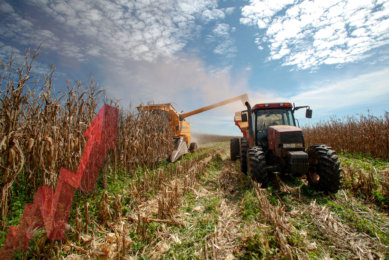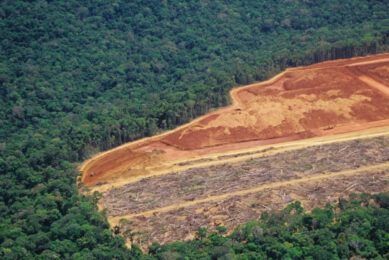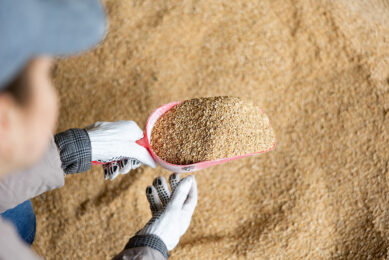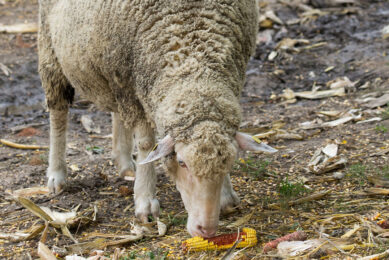Sustainability in focus at Tecaliman symposium
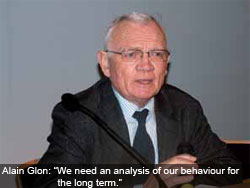
Sustainability in animal nutrition was the main focus of this year’s Tecaliman Symposium, which enticed a record participation of more than 160 delegates to Nantes, France on the 5th of March.
Tecaliman is a private association founded in 1981 by and at the service of the French feed industry with the support of the local Chamber of Commerce and Industry and J. Delort Laval, head of the laboratory of feed technology at the research institute INRA in Nantes.
“Globalisation has led us to all kinds of excesses and it’s the planet that is paying”, said Alain Glon, President of the Group Glon, who chaired the annual meeting of Tecaliman in Nantes this year. “We need an analysis of our behaviour for the long term,” Glon added.
In the first presentation of the morning, Arnaud Bouxin, Deputy Secretary General of European feed industry association Fefac, focused his talk on the sustainability of the sector with regard to the European institutions. “The pressure is growing on the feed sector”, stated Bouxin. A recent report published by the FAO (Livestock’s Long Shadow) concluded that livestock farming contributes more to global warming than driving cars. The World Wildlife Fund, states that the EU livestock sector has a responsibility in environmental pollution, linked to soy production in South America.
Another report published by the Friends of the Earth even recommends to produce more vegetable proteins in Europe and to reduce livestock production and consumption. “There are also national sustainability priorities”, said Bouxin. For Dutch, Belgian and Swiss citizens, deforestation is the priority, while it will be carbon footprint in the UK, Sweden and Finland. The ‘sustainability priority’ for Norway will be marine resources, industrial emissions in Germany, and the non-GM issue in Italy and Portugal.
“There are a lot of sustainability related initiatives in the feed sector”, Bouxin said, such as the Flemish agreement on proteins in feed (farmers who buy complete feed from compound feed manufacturers who voluntarily limit the amount of proteins in their feed benefit from more flexibility in manure land spreading operations) or the Round Table on Responsible Soy (www.responsiblesoy.org). Other individual initiatives exist, such as the calculation of carbon footprint of feed made by some feed companies such as Lantmännen in Sweden.
Developing sustainability policy
“The European Union progressively develops its policy of sustainability”, said Bouxin. A sustainable consumption and production action plan was published in July 2008 by the European Commission, and a retailer forum has been created to encourage retailers to commit to actions for promotion of sustainable production and consumption. “We cannot lag behind without communicating”, adds the Fefac deputy secretary. Fefac is preparing an environmental report of the feed industry for next September.
The feed industry also needs to coordinate with other chain partners as the Food Chain SCP Roundtable launched officially in March 2009. Fefac and Tecaliman also take part in European research programmes, for example theField2troughproject which has 4 objectives:
- Developing a vision on sustainable feed production,
- Developing and optimising technologies (e.g. reduction of energy consumption),
- Developing a tool to monitor progress towards more sustainable feed production for companies, and
- Evaluation of the sustainability of feed consumption.
The partners of this Field2trough project come from France, Belgium, Germany, the Netherlands (Wageningen University and Research Centre) and Serbia.
| Five guidelines to communicate on sustainability For Christophe Couroussé, Director of Communication, Terrena group, five guidelines need to be respected to build an efficient communication programme around sustainability:
As an example Couroussé mentions the ecologically intensive agriculture concept at Terrena, which has two goals: produce more with fewer inputs, and produce sustainable using techniques that are more respectful to the ecosystems. |
Carbon assessment
François Lucas, research technician for Tecaliman, focused his presentation on the Carbon Report applied in six French feed plants. The Carbon Report is a tool developed by the ADEME (Agency for Environment and Energy Management) and its function is to estimate the greenhouse gas emissions generated by the activity of an enterprise over the broadest possible scope of observation.
The application of this method in six feed plants led to interesting conclusions: agricultural raw materials account for 82.4% of the total greenhouse gas emissions globally, while transport of raw materials to the factory accounts for 7.6% of the total. Some factors influence the greenhouse gases emitted in the inter-mediate scope:
- Use of electric power generators,
- Specialisation of plants in poultry feed (use of a lot of steam),
- Types of feeds made (mash, pellets, heat-treated mash),
- Plants diversified by type of feeds produced (can be a greater number of customers supplied by one round).
“There is a need for in-depth and targeted investigations for transport and processing,” concludes Lucas. Only 10% of greenhouse gas emissions are under the control of factories and there is a lack of data on maritime, road and rail freight to describe the supply of raw materials. “The tool used (Carbon Report) is not suited for the quantification of greenhouse gas emissions for growing agricultural raw materials, because the factor for emission is known only for wheat,” concludes Lucas.
Energy Club
In a further presentation, Lucas supplied the delegates with feedback knowledge of the “Energy Club” from Tecaliman. “The goal of the Energy Club programme is to review the energy performance of production facilities every six months using a common method and to track performances by unit”, explained Lucas. The energy working group was created in 1986 with an inventory on 36 sites (consumption ratios, good practices guide). The history of Tecaliman’s energy activities includes 24 energy diagnostics from 1990 to 2000, 30 energy pre-diagnostics and 15 compressed air diagnostics from 1999 to 2005, 6 carbon reports from 2006 onwards and a crushing efficiency survey in 2008.
The Club’s second priority is an annual meeting whose objective is to provide input to improve energy management in the production units. Future energy-related issues are pelleting/cooling (60-80% of the energy consumption of a production unit), energy indicators (means of measuring and supervision fixed items, analysis of deviation), and the Tecaliman 2009 collective programme (definition of means of measurement and indicators). To find new and more efficient motors is a further issue as several indicators tend to show higher electricity prices in the short and medium term.
Round table
In the afternoon, a round table was organised on the topics: “Today and tomorrow facing sustainability,” led by Yanne Boloh, Philéas Info and François Lucas, Tecaliman. Hervé Vasseur, director of Cécaliment in Brittany, presented a good overview about his business and sustainability: “With more than 22 million tonnes of feed produced and delivered every year, the animal nutrition business in France is a big consumer of agricultural raw materials (22 million renewable tonnes) and transport (44 million tonnes).
Animal nutrition in Brittany, which accounts for 45% of this total, only produces 35% of the raw materials that it uses. It is a productive region, highly specialised in livestock. This intensification allows for a certain level of competitiveness. As in every crisis, this concentration is consolidating”.
While most raw materials come from the west of France, some may cover several thousand kilometres (sorghum from the US, corn from Brazil, cassava from Thailand). “The sector is looking into collective projects to diversify the means of transport, but rail transport must become more efficient and our ports must improve if they are to challenge our competitors”, comments Vasseur, adding that “the 44 million tonnes in association with rail and sea transport has proven its value in terms of sustainable development. Could Brittany be the test region? The sector proposes solutions to save resources but the authorities are often lagging behind. Productivity remains a priority for our future and is not in opposition with sustainable development. We possess the farmer’s economical common sense”, concludes Vasseur.
“Which technique is more favourable for sustainable development? We still have to create an assessment tool”, adds Lilian Leloutre, Head of Ruminants R&D at INZO. Regarding ruminants and methane for example, animal intensification can help to reduce the production of methane per litre of milk produced, but it usually results in higher energy costs.
Greenhouse gas emissions
Regarding raw materials, what are potential greenhouse gas emissions? Claude Tauveron from Cybelia, presented some figures regarding the energy consumption of feed mills. For electricity, the energy consumption varies from 25 to 50 kWh/t, depending on the type of production, with an average of around 35 kWh/t produced, i.e. 3 kg/t of greenhouse gas, (for the highest energy consumers: pelleting and crushing). For steam, energy consumption varies from 25 to 45 kWh/t, depending on the type of production, with an average of around 38 kWh/t for pellets, i.e. 8.8 kg/t of greenhouse gas. For compressed air, the energy consumption varies from 0.6 to 6 kWh/t produced, or an average of 0.30kg/t of greenhouse gas.
*Philippe Caldier is a regular freelance writer for Feed Tech from France.




